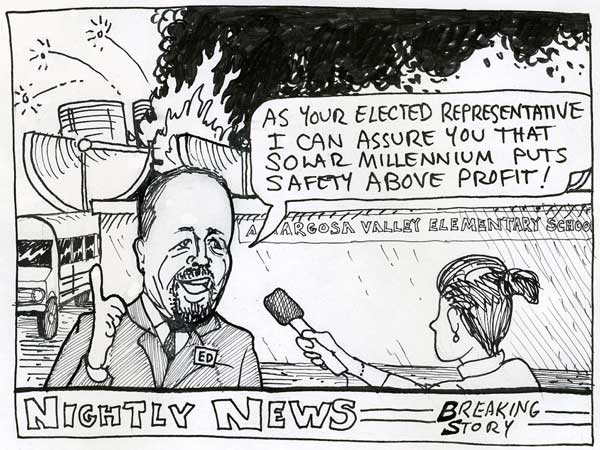Try Again: Beatty Public Meeting on Solar Millennium's Amargosa Valley Project
September 22, 2009 - Community Center, Beatty, Nevada
A second public scoping meeting was held by the Bureau of Land Management (BLM) this evening, to make up for the last meeting on September 3rd that did not allow the public to actually speak (written comments only were accepted). After nudging by the ACLU and outcry by locals, BLM "redid" the meeting to collect comments concerning Solar Millennium's Amargosa Farm Road solar thermal project about 30 miles to the south.
A similar BLM scoping meeting had already taken place in the town of Amargosa Valley (see our coverage >>here), and emotions ran high as a majority of residents told the company and BLM employees that they did not want such a plant so close to their schools and homes. Solar Millennium is seeking to lease public land to build its thermal trough-mirror plant with steam turbines and experimental molten salt storage tanks that store heat a few hours after sunset, that would sit right in the middle of the town.
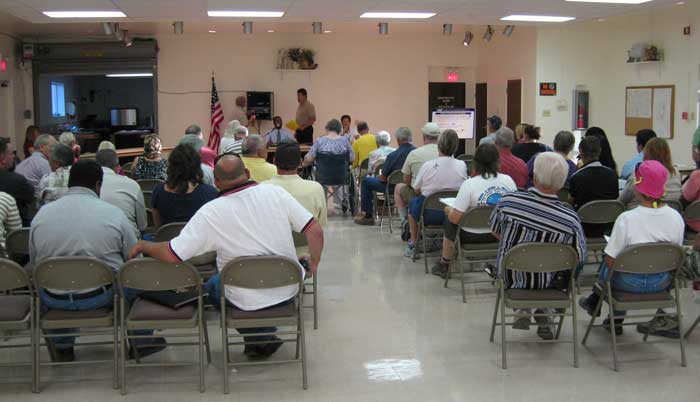
About 50 people crowded into the room, including several Beatty residents, as well as many vocal people from Amargosa Valley. Half the spoken comments were against the project, and half were in support. The supporters all seemed to be union workers hoping for "green jobs," but interestingly these men all held the same notebook, had similar statements, and then gathered around Nevada Assemblyman Ed Goedhart (R-central Nevada counties) after the meeting ended, applauding him whenever he spoke. Did he ask these folks, some admitting to be from Las Vegas, to come and voice support for Solar Millennium? We find it amusing he did not face Amargosa Valley residents whom he represents at the meeting there.
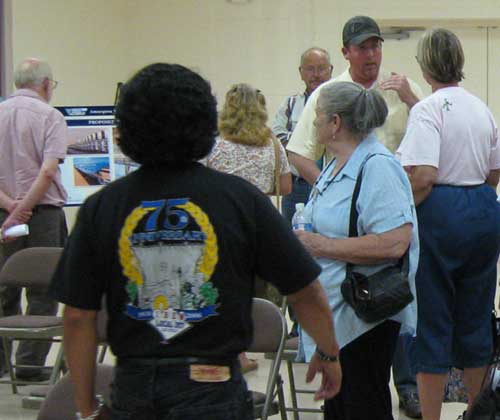
Goedhart lives in Amargosa Valley and is general manager of the Ponderosa Dairy.
<Ed Goedhart talks with a local woman after the meeting, while a man from Las Vegas wearing a labor union T-shirt walks over to converse.
Water, Fire Safety, Dust
BLM's Greg Helseth (renewable energy coordinator) and Mark Chandler (realty specialist) announced that the deadline for scoping comments on the Solar Millennium project had been extended to October 19, 2009. The Draft Environmental Impact Statement (DEIS) was due out after January 1, 2010.
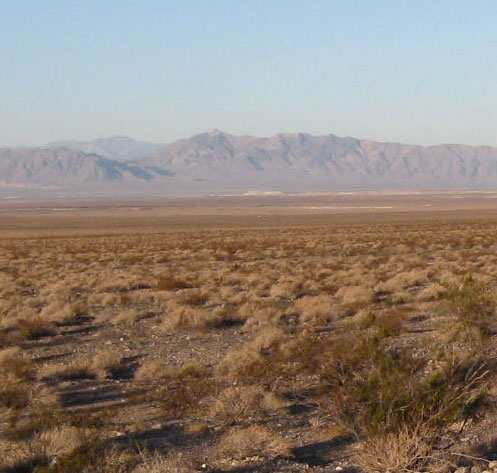
>View of Amargosa Valley looking west, with Telescope peak on the horizon in Death Valley National Park.
Greg Helseth told the audience, "We came back to correct our mistake", to allow everyone who wanted to a chance to speak directly into the microphone and say out loud their comments, "as we did at the other meetings."
Amargosa Valley residents spoke up. Many had questions about whether the volunteer fire department would receive increased services? Answers would be given in written form in the dEIS, replied Helseth.
"We are not against solar power," another Amargosa Valley resident said. But he was against this type, at this location, "on our main street." He said it was "outrageous" to put this plant in a small town, and noted that in Spain, Solar Millennium built a similar solar thermal plant away from communities. He mentioned the worry over an explosion like that at the Daggett solar thermal plant in 1999 in the California desert, as well as concern about the over-allocated water in Amargosa valley. "We are a desert," he reminded the company and BLM. He claimed a few people own a lot of water rights and stand to make a lot of money on leases of water. "We are not NIMBYs, we are: 'Not in Amargosa Valley'", he ended.
Another 15-year resident of Amargosa Valley wondered if a deal had already been struck for leasing the 4,000-5,000 acre-feet per year needed by Solar Millennium for its wet-cooling system.
A teacher in Amargosa Valley brought up concerns with the school that would be next to the solar plant. "We don't have any crosswalks," she said, and the amount of truck traffic going by the school on the small road was a threat.
A Beatty resident brought up the point that after all the vegetation is scraped off, dust will be a big issue. And when the alfalfa farm water is transferred to the solar plant, what will happen to those green fields when they dry up? (After the meeting Jason Higgins, a Solar Millennium representative told us that a local mine would supply the company with a special kind of gravel that would be placed on the ground surface to keep dust down.)
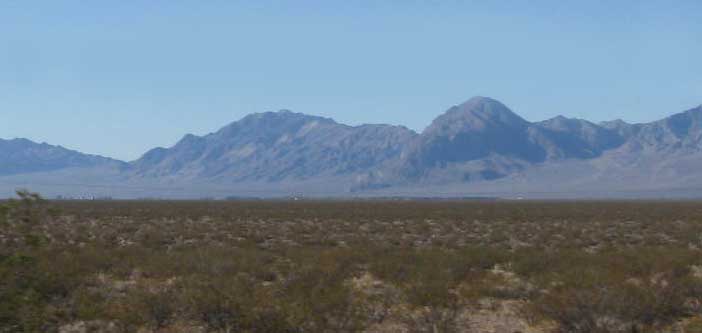
^Site of Solar Millennium's power plant project, with the town and farms in the distance below the peaks of the Funeral Range, which are in Death Valley National Park. The park boundary lies about 5 miles from the proposed project site.
"Green Scabbing" and "Greenmailing"
Other audience participants spoke in favor of the solar thermal project, citing jobs. At least one Amargosa Valley resident, and four or five union workers, several of whom said they were from Las Vegas, told the crowd how Nevada needed these "clean power" jobs; this need outweighed any "negative impacts." One man said he thought Solar Millennium made a "strong commitment" to put Nevadans to work. "A lot of people are hungry." He admitted it was wrong to bring "Guatemalans" in to build the Boulder City solar plant, but that Solar Millennium said it will hire Nevadans.
He was referring to the controversy over the Nevada Solar 1 plant in Boulder City's Green Energy Zone: the Spanish company Acciona who built and operates the plant promised to hire Nevadans at a fair wage after receiving a $15 million tax rebate from the Nevada Commission on Economic Development. But they turned around and hired workers from Central America and Mexico, angering unions (see article in the January 2009 Las Vegas Sun).
Lorraine Younghans, member of the Beatty Town Advisory Council, spoke back to these comments. She said BLM would be "very derelict" allowing this system to be built as it uses too much water. "As for jobs," she continued, the "big plans" for solar development look good, but when they are done plants like these will have only three employees. Murmurs rose from the audience.

Robert Conway spoke next, in favor of the project: "Hopefully" it will involve a labor agreement with building trade unions, "so there will be careers." He explained how unions have apprenticeship programs to train people.
We note that in California, several large solar projects on BLM land are not agreeing to hire union workers, and are being pounced upon by California Unions for Reliable Energy (CURE), a consortium of Union leaders working together to increase organized labor’s stake in California’s energy infrastructure.
After Stirling Energy Systems filed plans with California regulators to install 30,000 solar dishes on 10 square miles of desert land, its executives got a call from Marc Joseph, the union lawyer for CURE. Sean Gallagher, a vice president for Tessera Solar, the development arm for Stirling, said the company declined Joseph’s request to commit to using union labor. CURE then filed 143 data requests with the company on the final day such requests could be made, and later intervened in a second, 850-megawatt Stirling solar project. The data requests were for every minute detail of biological surveys, requests for resumes, critiques of flood control plans, and pages of questions and more questions that SES had to respond to. (See our story on the SES Solar 1 project near Cady Mountains, California >>here. CURE intervened on this project and sent a barrage of data requests to the company through the California Energy Commission >>here, slowing down the application process).
It was a different story after BrightSource Energy pledged to hire union-friendly contractors to build its Ivanpah solar power tower complex. Despite questions raised by environmental groups about the project’s impact on wildlife, the union group took no action, according to California Energy Commission documents. If the company commits at the outset to use union labor, CURE never makes its environmental objections.
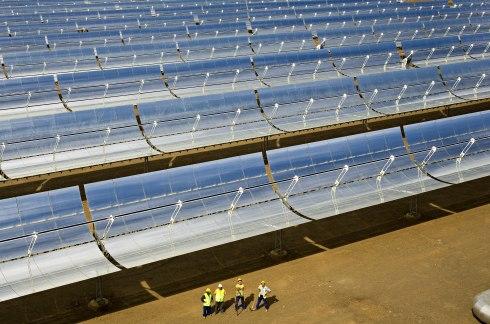 “These environmental challenges are the unions’ major tactic to maintain their share of industrial construction — we call it greenmail,” said Kevin Dayton, state government affairs director for the Associated Builders and Contractors of California. “The future of solar energy is jeopardized by these unions holding up construction." In California, project labor agreements can raise costs on a project by about 20 percent, Dayton estimated. (From the New York Times)
“These environmental challenges are the unions’ major tactic to maintain their share of industrial construction — we call it greenmail,” said Kevin Dayton, state government affairs director for the Associated Builders and Contractors of California. “The future of solar energy is jeopardized by these unions holding up construction." In California, project labor agreements can raise costs on a project by about 20 percent, Dayton estimated. (From the New York Times)
We do not know what will happen in Nevada, but we recall that Don Reid, a project manager for Solar Millennium at a May 2009 open house in the Longstreet Casino south of Amargosa Valley was accompanied by a construction specialist from Spain who helped build the company's Andasol projects. Reid referred us to the Spanish worker for all questions concerning the technology of the plant.
According to a presentation given at Solar Power International in 2008 in San Diego,
Solar Millennium’s Development Strategy for their North American market would be to "utilize the Solar Field construction force for [a] large, multi-year effort," using its "Solar Millennium qualified Engineering & Construction Team." In California they secured a property tax exemption to reduce costs.
Nevada enacted a law that a solar company can apply for up to a 55% property tax abatement for 20 years, and a sales tax exemption for 3 years, if it agrees to hire a certain number of full-time employees during construction, a percentage of whom must be Nevada residents, ensure that the hourly wage paid to the facility's employees and construction workers is a certain percentage higher than the average statewide hourly wage, and provide the construction workers with health insurance. (Source: Database of State Incentives for Renewables and Efficiency)
According to Greg Helseth, BLM will not be involved in any hiring quota for union or local jobs, even though a company is leasing federal land.
Ed Goedhart Speaks
"I've been against Yucca Mountain [nuclear waste dump]," Nevada Assemblyman Goedhart (R-Nye County and other adjacent rural counties) said. "But we've ceased to become a country that makes things -- we need a strong, vibrant economy."
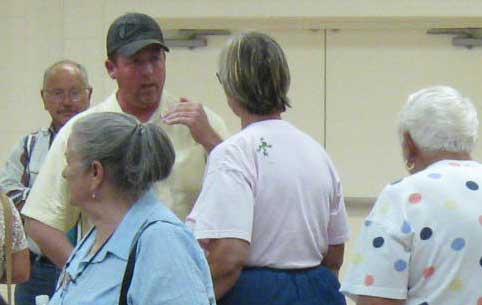 He went on to say how this project would bring several million dollars to Nye County and more to the state budget, which needs it. It would "help seniors, libraries, schools...." He said the European Union summit on climate change and the Kyoto Treaty want cap-and-trade. "This is the future!" he went on to describe how he has four houses all near the project site, "and I'm O.K." "A recession is when your neighbor is out of work, a depression is when YOU are out of work." Goedhart said Nye County's unemployment rate is 16%, and if you add underemployment it goes up to 30%. "One in nine Americans is on food stamps," he explained. "Nye County needs to move forward."
He went on to say how this project would bring several million dollars to Nye County and more to the state budget, which needs it. It would "help seniors, libraries, schools...." He said the European Union summit on climate change and the Kyoto Treaty want cap-and-trade. "This is the future!" he went on to describe how he has four houses all near the project site, "and I'm O.K." "A recession is when your neighbor is out of work, a depression is when YOU are out of work." Goedhart said Nye County's unemployment rate is 16%, and if you add underemployment it goes up to 30%. "One in nine Americans is on food stamps," he explained. "Nye County needs to move forward."
Claps resounded from the audience, from the union supporters mostly.
One man stood up and said Goedhart expressed every sentiment he shared. "We need a future for our children." He told us this was a "national security issue," Nevada should get self-sufficient with its natural resources. And safety was a concern, he admitted, but "we can have a safe environment to live in, and good paying jobs."
"If you want to have an omelet, you have to crack some eggs!"
Some Amargosa Valley residents did not seem to agree. One man got up and said he was "glad our Assemblyman is moving his attention to Kyoto, which will never be ratified." He commented on how Spain's solar industry is heavily subsidized, and that the Spanish solar company Abengoa's costs makes its electricity double that of coal in price.
Goedhart responded by flinging his imagination toward the future: "We will have solar cars soon!" he exclaimed.
One of the last to comment was a man from Nelson, Nevada, who was proud to have mines in his community. "If kids in Amargosa Valley grow up and learn this [solar] technology, they will be very proud."
An Amargosa Valley man replied that there seems to be a generation gap controversy in this discussion. A lot of residents were retired, and so health and safety were more of a concern that green jobs.
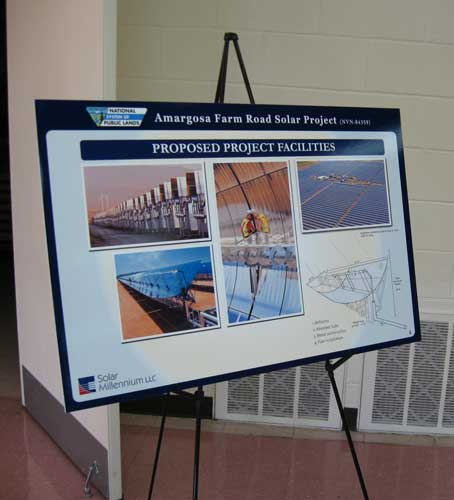
The meeting adjourned with a lot of heated discussion afterward. We asked Jason Higgins, of Solar Millennium, if they had their power purchase agreements in place yet. He said they were still in negotiations. Phase one of the Amargosa Farm Road solar project would most likely go to the local co-op utility Valley Electric, which would then roll over much or all of it to NV Energy of Las Vegas. We asked what percentage would go to California? Higgins would only state that, "We have not negotiated phase two yet."
HOME.....Solar Millennium Project in Amargosa Valley
Scoping Meeting in Town of Amargosa Valley (August 2009)
